Energy efficiency is an important element to consider while window treatment shopping. The most energy efficient window treatments can improve your home in more ways than one. They can regulate temperatures, improve quality, and shield your home from harsh sunlight. Most importantly, they are financially smart and save money on your monthly energy bill.
Are you interested in finding energy efficient window treatments for your home? It can be hard to know where to start the search.
Luckily for you, we’ve created a guide to the most energy efficient window treatments. Here you’ll find our top five recommendations. Plus, we’ll explain why energy efficiency is so important in the first place.
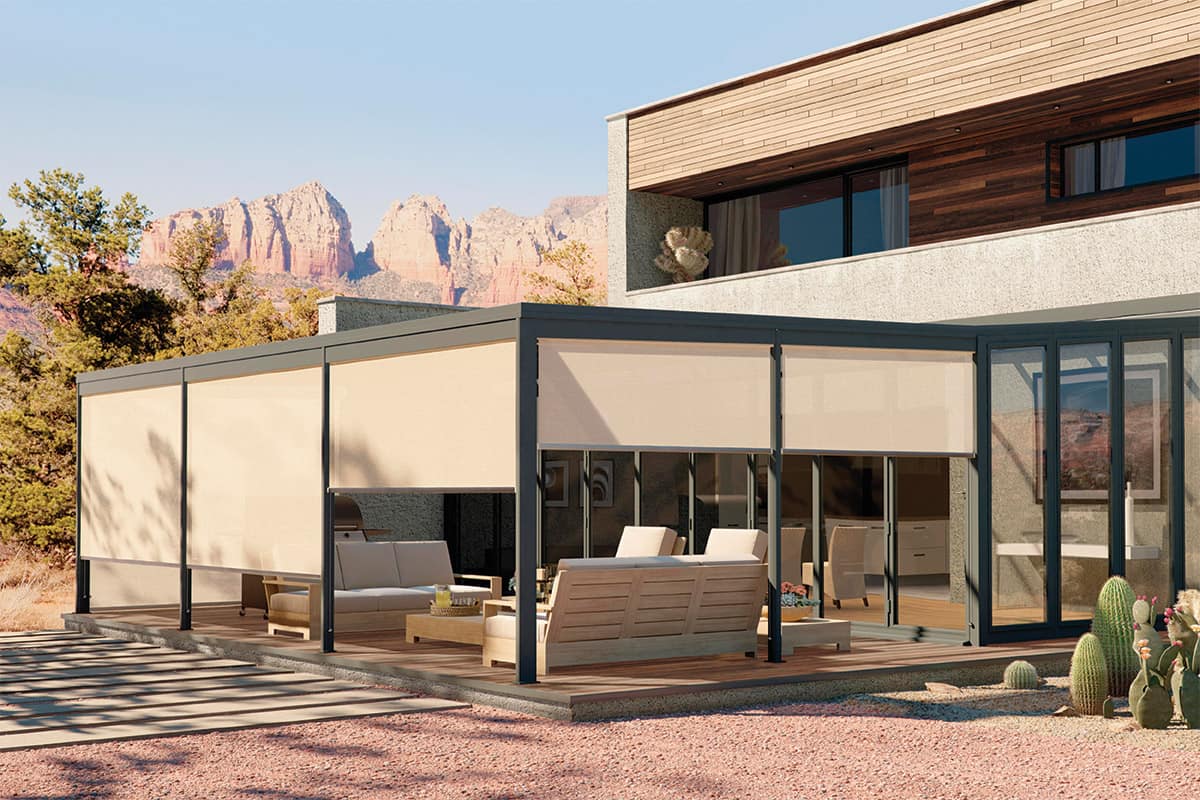
What are energy efficient window treatments?
Let’s start with a simple fact. Every year, about 30% of a home’s heating and cooling energy escapes through leaks in windows. For older homes, that percentage can increase to 40%. That means you waste almost half the dollars you spend on your energy bill.
Does that percentage seem particularly high to you? Yeah, it’s a bit concerning. We spend so much money on heating and cooling each year. And frankly, it is discouraging to think that our energy bill is more expensive than it needs to be. Why are our windows so poorly insulated, and what can we do about it?
This is where the most energy efficient window treatments come in handy. Window treatments can provide insulation and light control to maintain your home’s energy. In the tricky summer and winter months, energy efficient window treatments regulate temperatures. Most importantly, they keep your energy in the home where it belongs.
The most energy efficient window coverings save you hundreds of dollars in the long run. They also help cut back the harmful effects of fossil fuel consumption. So if you are someone who likes to keep your home environmentally friendly, these coverings might be for you.
How do energy efficient window treatments work?
Energy efficient window treatments’ unique and effective designs are incredible at controlling temperatures. When it comes to how these window treatments work, there are two elements to consider: insulation and light control.
Insulation is especially important in the chilly winter season. It’s easy for hot air inside your home to escape through leaks in your windows, causing your energy bill to creep up. Insulated window coverings combat this. The designs are created to trap or block air. This keeps the warm air where it’s meant to be — in the home.
Light control in window treatments is more necessary in the sunny summer months. Harsh solar rays can cause the heat in your home to rise. This makes it harder to keep your internal temperatures cool. Energy efficient window treatments reflect the bright sunlight back outdoors. The extra shade inside keeps the temperatures down and your energy bill happy and low.
The top five most energy efficient window treatments
Many window treatments provide a degree of light control or insulation. However, there are a few coverings that are specifically made to be energy efficient. Material, design, and style all play a key role in what makes these our top five recommendations for the most energy efficient window treatments.
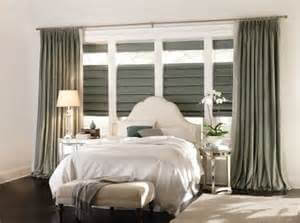
Roman Shades
Roman shades are one of the most elegant and romantic window treatments available. Styled to have soft, draping pleats, Roman shades are a graceful and timeless choice for your home. They can either add subtle beauty to a room or dramatize your home’s atmosphere with an ornate finish. Plus, they are available in a wide range of fabrics and colors to choose from. As stylish as Roman shades are, they are also functional and user friendly as well.
Are Roman shades energy efficient?
Roman shades are energy efficient due to the shade’s thick fabric and folds. They are designed to fit neatly within or outside the window casing. This means the shade envelopes the window and gives more coverage when lowered.
With heavier, pleated fabric, Roman shades provide a thick layer of insulation to a window. This extra layer is beneficial in the winter, keeping warm air from escaping. If you prefer the appearance of lighter fabric, you can add a thermal backing to keep your windows insulated. Over time, you’ll see that your energy costs are lower than they once were.
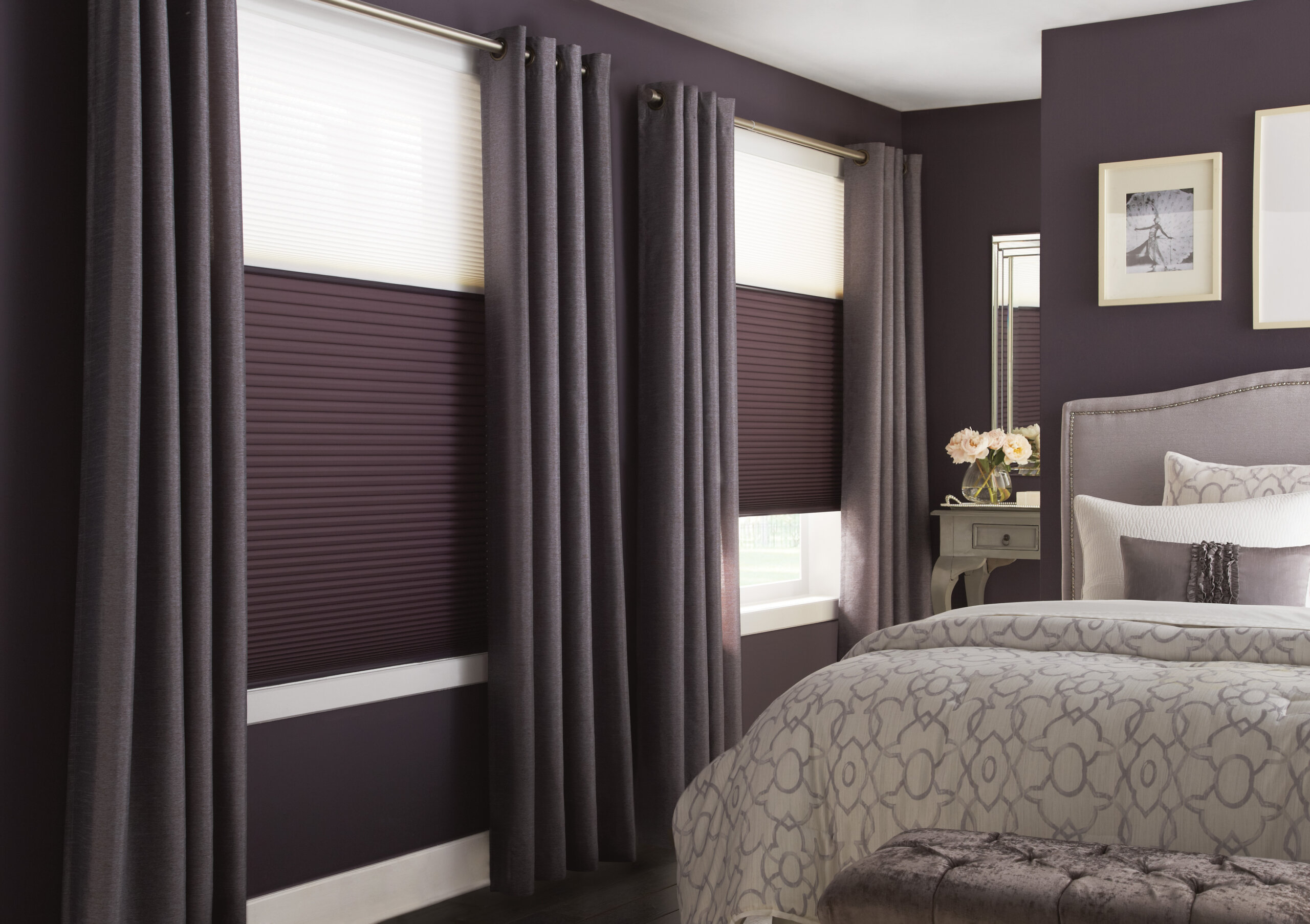
Cellular Shades
Cellular shades are one of the most unique window treatment designs. Made of pleated materials, the shade is structured in a series of cells that resemble honeycombs. The pleats fold smoothly together like an accordion when you want to raise the shade.
Beyond the structural genius of cellular shades, they are also customizable. You can choose a variety of colors and fabrics to match your home’s aesthetic. Cellular shades can also fit difficult window shapes like arches and doors. Plus, they can come in sheer or blackout fabrics to provide more light control and visibility. The pleats themselves are customizable too, coming in 3/8-, 9/16-, 1/2, and 3/4-inch sizes.
Are cellular shades energy efficient?
Created after the energy crisis of the late 1970s, cellular shades are the most energy efficient shade. The honeycomb cells are structured to trap air and provide insulation. These tight air pockets have the ability to reduce heat loss by more than 40%. In the hot summer season, cellular shades can also reduce solar heat by 60% when the shades are closed. These statistics are significantly better than the usual amount of energy lost. It is clear that cellular shades are a powerful asset to protect your home’s energy costs.
Cellular shades can also be layered to provide even more insulation. The more cells you have, the more guarded your windows and energy levels will be. Here’s what you need to know about single, double, and triple cell shades.
- Single cell shades — These are the most affordable and common cellular shades. Single cell shades have only one row of honeycombs. They are best used in homes where energy efficiency is less of a goal. If you are looking to upgrade later on, these might be a good fit for you. Single cell shades are less expensive and easier to add liners or motorized controls.
- Double cell shades — Double cell shades have two layers of honeycomb fabric. This is a great option if you want a little extra insulation. However, they are pricier and have a bit more limitations to upgrades. Double cell shades are still customizable, with your choice of fabrics and colors.
- Triple cell shades — Triple cell shades are the king of energy efficiency. The three layers of pocketed cells are a thick barrier, trapping air and providing lots of insulation. Triple cell shades are most useful in homes that have an extreme need for insulation. With these shades, your energy bill will be significantly lowered.
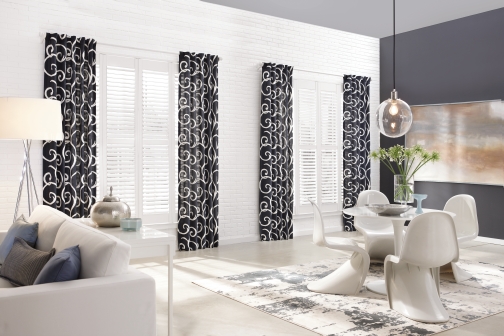
Draperies and curtains
Draperies and curtains are window treatments that will never go out of style. Classic and elegant, draperies add a level of dimension and character to any room. With a variety of fabrics and textures to choose from, draperies can dress up or simplify a room. The soft fabric of curtains can make any atmosphere warm, inviting, and sophisticated.
Are draperies energy efficient?
Energy efficiency in draperies can depend on a variety of factors. The short answer, though, is yes. Draperies are another great choice if you are looking for window insulation. Since draperies are attached to the outer frame of the window, they have more coverage than many other window treatments. Draperies can also be more effective if they are hung close to the window, especially with fabric that is floor-length. You’ll want to make sure you seal the curtain fabric to the sides of the walls with a hook to get the greatest reach.
How energy efficient your drapes are can also depend on the fabric you choose. Thicker fabrics will provide more insulation. Colors that are more medium tone will also absorb light streaming in from outside. If you want more insulation, you can layer your draperies or add a thermal or white-plastic backing. Combining a drape with a white-plastic backing can reduce heat gains in the summer by over 30%. In the winter, draperies can even reduce heat loss up to 10%, keeping warm air inside. Therefore, draperies are not just a beautiful compliment to your home. They also save you some bucks when it comes to your energy bill.
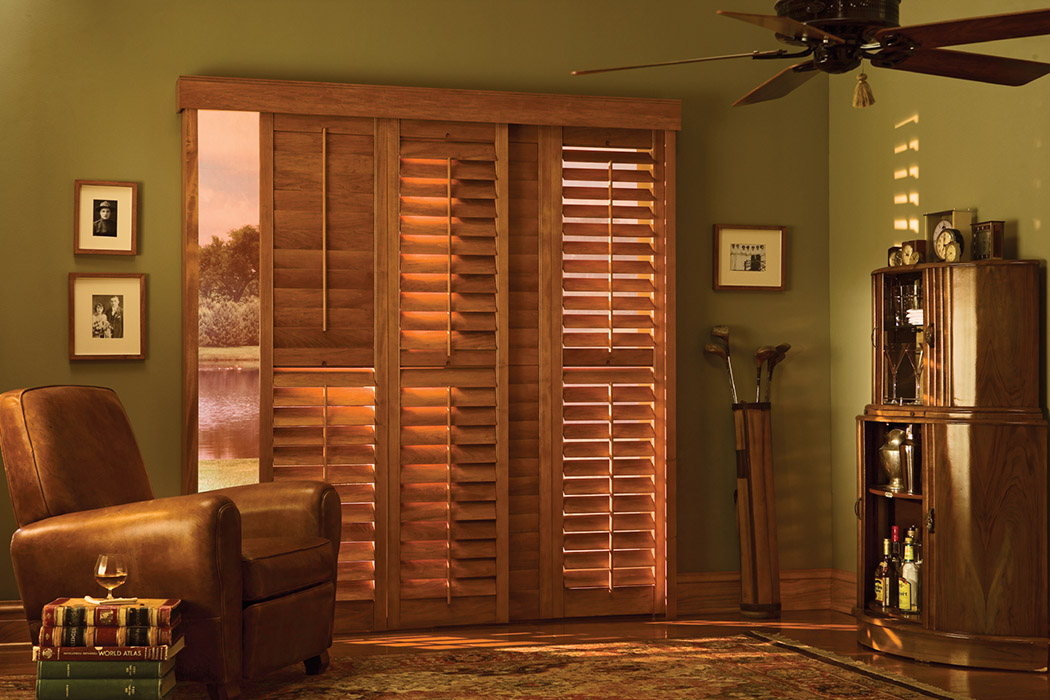
Shutters
Shutters have been around for centuries. Built with a classic structure, shutters have vertical stiles and horizontal rails attached to a window frame. Yet, there are many kinds of shutters beyond the basic structure. Panels and louvers (horizontal or vertical slats) can change shutters’ shape and design. Plus, there are a variety of materials to choose from. Wood, glass, plastic, and even fabric are only a couple of the options.
Shutters are a unique window treatment when it comes to placement, too. Unlike many coverings, there are interior and exterior shutters. You can also fit shutters to doors or other windows with unique structures.
Appearance-wise, shutters are traditional and beautiful. With so many colors and designs to choose from, you can easily find the right shutters for your home.
Are shutters energy efficient?
Shutters are very energy efficient due to their sturdier materials. These thick materials, such as wood or plastic, can trap air and add insulation. Shutters are also tightly connected to the window frame. The smaller gaps between the treatment and the window structure causes less air to escape.
The louvers of your shutters can also control light. In the summer, you can close them to block light and heat. One popular type of interior shutters with louvers is plantation shutters. With plantation shutters, you can even open your shutters like a door. This can be helpful in the winter, when you want more sunlight to naturally warm your home.
Shutters don’t only save money on your energy bill. They are also a financial asset since they are the only window treatment to add to a home’s value. Shutters are a permanent addition since they’re built into the window frame. Thus, they save you money on energy while also returning your investment if you sell your home in the future.
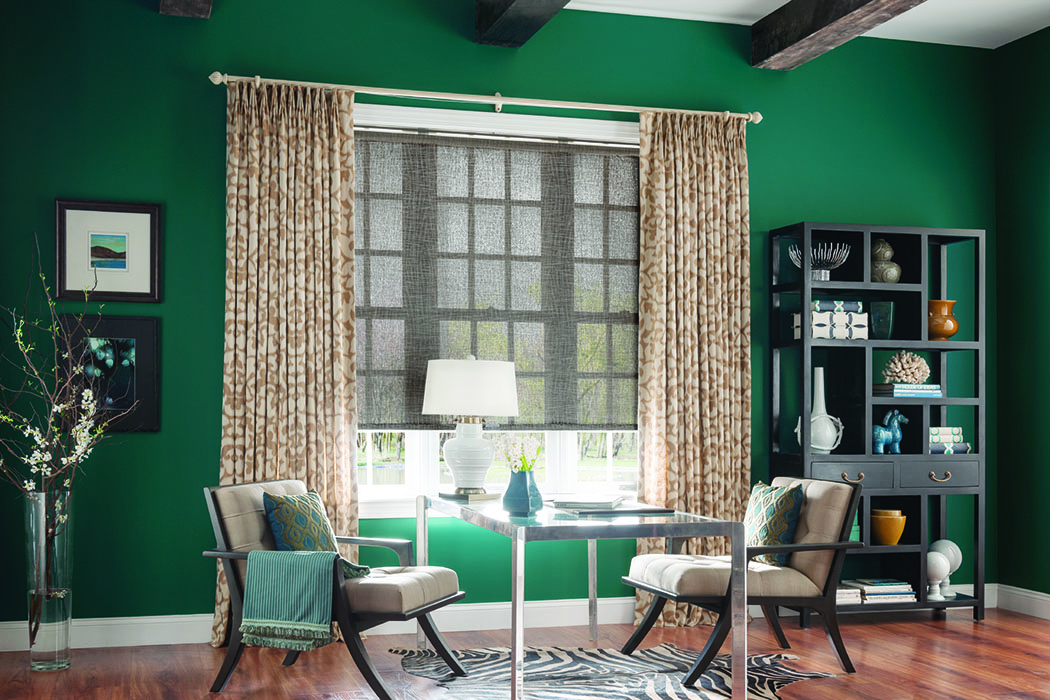
Solar Shades
Solar shades are ideal for homes with a view and for those who love natural light. These beautiful shades are similar to roller shades, with a single large shade. However, solar shades have a unique material that provides light control while still allowing a view outside.
With solar shades, you can choose the opacity of your shade. This opacity — or openness percentage — determines the visibility and effectiveness of your shade. The higher the openness percentage, the larger the small holes in the fabric will be. This will let in more light and create more visibility. The lower the percentage level, the tighter the fabric will be woven, blocking more light.
If you want UV protection and light control, yet love a view, solar shades might be a perfect fit for you. They are great for sunrooms, and they can even be used for exterior patios. Plus, solar shades have a streamlined and simple appearance, looking fantastic in your home.
Are solar shades energy efficient?
In hot climates, solar shades are a good choice for an energy efficient window treatment. The opaque fabric blocks the UV rays and most of the harmful light that enters your home. This does not only protect the wood and fabrics of your furniture. It will also keep your temperatures down, minimizing the glare and heat. This is especially effective in rooms with large windows, where you want to be able to see the view outside. With solar shades, you can still see the beautiful outdoors — and save money on energy at the same time.
If you want your solar shades to be more energy efficient, you can lower the openness percentage. This will create a tighter weave, creating more of a blackout shade. Or, if you prefer your visibility, you can layer your solar shades with another shade. That way you can lower another shade during the brightest hours of the day.
When it comes to winter, solar shades are good for letting some natural light to warm your home. However, they don’t provide the most insulation. If you worry about warm air escaping your home during colder months, you might want to layer your solar shade. Pair it with draperies or another shade for max insulation.
Create your own energy efficiency
Even if you don’t have the most energy efficient window treatments, you can still reduce your energy bill. How? By manually opening and closing your window treatments during the right times of day.
For example, in the summer months, you can keep your treatments closed during the brightest parts of the day. This will provide shade and keep cooling costs down. In the winter, keep your window treatments open during sunny days to let bright light warm your home. At night or on cloudy days, close your treatments to keep the warm air insulated inside.
If that sounds like lots of effort, you may look into motorization for your window treatments. With motorized treatments, you can lift and position your coverings with an easy push of a button. Plus, you can schedule your treatments to open and close during the brightest times of day. So even while you are out at work, your window treatments will still open and close at the right times of day. This can really save money on energy, while protecting your furniture and privacy as well.
If you want to learn more about energy efficiency, you can schedule a consultation with Made in the Shade. One of our experts would be happy to help you find the perfect window treatments for your home.










